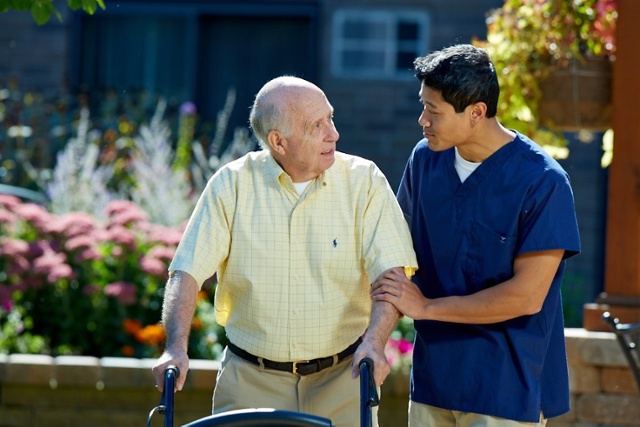
As the leading cause of injury among Americans aged 65 and up, falls are incredibly common among seniors–but they're also largely preventable. The Centers for Disease Control and Prevention (CDC) estimates that across America, one older adult falls every single second, and one in four seniors will fall every year, and even small falls can be serious. Adequate fall prevention can be the difference between safety and injury for seniors.
Whether older adults live in a senior living community or at home, these fall prevention tips may help reduce your loved one's chances of falling and subsequent trips to the emergency room so they can live a happier, safer life.
A FALL PREVENTION CHECKLIST TO KEEP SENIORS SAFE
- Keep outdoor walkways clear. Older adults are more likely to fall in the winter. If your aging parent or grandparent goes outside, make sure their walkway is clear. Sweep away stones and leaves, level out uneven sidewalks, and use salt to melt ice at least 15 minutes before they walk on any frozen walkways in the winter.
- Clear the floor inside. Remove throw rugs, which can present a tripping hazard when they get caught on shoes, canes and walkers. Move boxes, cables and wires, shoes, and anything else that could get caught underfoot out of the way.
- Use non-slip mats on linoleum and tile. Mats and decals can provide traction on bathroom, kitchen and shower floors. Consider adding these mats to any surface that's slippery even when it's dry.
- Install grab bars at key locations around the house. Anywhere an older adult regularly sits and stands, like near the toilet, bath, or shower, can be a potential fall location. A simple metal bar can provide stability when sitting, standing, or just rounding a corner.
- Keep commonly used items in easy-to-reach places. Anything your loved one uses regularly should be stored in an easily accessible location. Bending over, stooping, and reaching can cause aging adults to lose balance and feel dizzy, often leading to a fall. Avoid placing frequently used items in low drawers or cabinets.
- Install handrails and masking tape to stairs and walkways. If a person loses their balance on a staircase, make sure there's something for them to stabilize themselves with. Colored masking tape on the edge of each step can help delineate them for those with poor eyesight, reducing the chance of tripping.
- Install motion-activated lighting in key areas like hallways, bedrooms and bathrooms. Motion-activated lighting placed in frequently visited areas can make it easy to see underfoot, reducing the risk of a trip or misstep. Place flashlights within reach of beds and in other areas of the home in case of power outages.
- Install a colored toilet seat. A study by the CDC found that more injuries occur when using the toilet than in the shower or bathtub. Choosing contrasting colors for the toilet seat can help older adults know which position the seat is in before sitting down. Try installing a black toilet seat on a white toilet to increase the contrast for adults with weaker eyesight.
GOOD HABITS TO PREVENT FALLS
In addition to making your loved one's living space more fall-proof, you can reduce their risk of falls with daily practice and diligent habits.
There's No Rush–Take Your Time Sitting and Standing
You can reduce the risk of a fall by encouraging older adults to sit and stand slowly. Remind them that it is okay to move slowly because changing positions too quickly can cause a sudden change in blood pressure, which may result in your loved one becoming dizzy, losing consciousness, and falling.
Keep Them Moving
Staying active is a great way to help prevent falls or other injuries. Remember, being active can be as simple as walking 10 minutes a day, doing tai chi, or low-impact fitness exercises, like Core Stix or chair yoga. With a doctor’s approval, other options for exercise include a favorite sport such as golf, tennis, swimming, bicycling, resistance training or Rock Steady Boxing.
Keep Pet Feeding Time Fall-Free
If your loved one has a pet, training is essential. An excitable dog or cat can be rambunctious when it comes to feeding times, so make sure any pets are trained to wait patiently for breakfast and dinner so as not to get underfoot potentially causing a tripping hazard.
Review Their Medications
Make a list of all the medications your loved one is taking, including over-the-counter medications and supplements, and review them with their doctor. This will help you determine if any medications could interact to affect balance, if there are any medications they can reduce or replace, or if they can add a medication that could help maintain strength or balance and reduce the risk of a fall.
Keep Their Doctors' Appointments
Risks of falling aren't limited to things underfoot. Health, medications, and activity levels are also factors that can either contribute to or reduce your loved one's risk of a fall. That's why it's important they have regular health checkups where your loved one can talk to their doctor about the risks of falling. Make sure they're on a regular checkup schedule with their general physician and make appointments to meet with specialists to check their eyesight and hearing, as well.
Besides preventing falls, being physically active helps maintain fitness and strength to keep doing the things your loved one enjoys. Plus, moderate exercise can improve cardiovascular health, bone density, autoimmune functionalities, and contribute to a longer life.
With discipline, care, and good habits, you can reduce the risk of a devastating fall in older adults. The safer your loved one is, the more independence they feel, and the greater quality of life they'll have for years to come.

